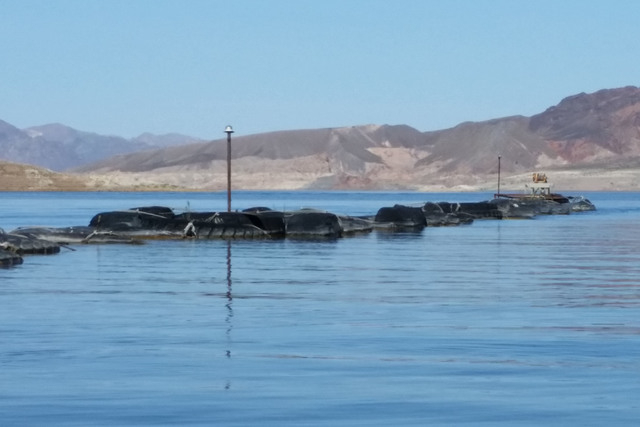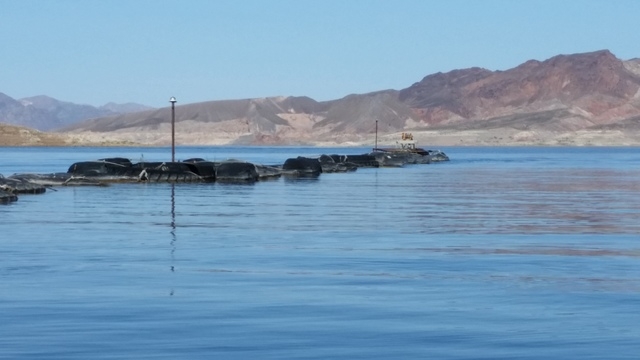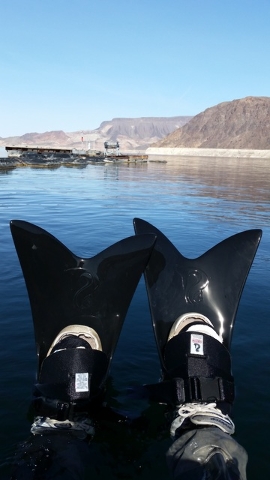Float tubes provide anglers with many opportunities



Last week, I wrote about the origin of float tubes and their use as a fishing platform, primarily on small waterways. But they also can open the door to fishing opportunities on larger waters such as Lake Mead or Lake Mohave. It just takes a little creativity and effort.
Lakes Mead and Mohave are among the country’s largest and busiest recreational waterways, which means they attract boaters with a variety of interests ranging from fishing to water skiing and from pleasure cruising to going as fast as possible. That means a float tubing angler could find himself competing for a little water space with everything from a 12-foot aluminum fishing boat to a 50-foot go-fast boat and everything in between.
This kind of boating traffic can be a little intimidating and make things dicey for craft as small as a float tube.
Something else a float tuber should consider when it comes to big water is the list of problems inclement weather can bring, especially the wind. Strong winds, for example, could easily blow a float tube and its passenger a great distance across an open basin such as those found at Mead or Mohave. While these concerns are real, there are some things you can do to reduce the risks and create a fishing niche for your tube on large waters.
One thing big waters have a lot of is shoreline, and you will want to associate yourself with it. In other words, stay close. The first thing you will need is an access point where you can launch your kick boat.
Keep in mind that to launch your tube, you need to be able to walk into the water backward, and there is no graceful way to get into a tube. Look for someplace where you can wade backward without stepping off a steep underwater slope.
Remember that you also will need a place to get out of your tube when you are done. The back of a cove is a good place to look, as are long, low points. Avoid anything steep, especially if it is covered with loose rocks that can roll out from under your feet.
In a manner of speaking, coves also offer float tubers the chance to shrink a large lake or reservoir. Select a cove, or even a series of small coves that have the habitat requirements for the fish you are looking for. Since you don’t want to compete with boating traffic, select a location off the beaten path. Then make the conscious decision to work the area slowly and methodically. After all, you aren’t going to be racing between shorelines. This will take you out of boat traffic lanes and can help protect you from wind.
On a recent trip to Lake Mead, for instance, I fished a small area squeezed in between the tires marking a marina boundary and the shoreline. Boaters launching from the marina tend to overlook this little spot in their hurry to go elsewhere. Since fishing is not allowed inside the marina, I had to kick about 15 minutes before reaching fishable waters, but doing so gave me access to a somewhat protected area with six small coves to fish while remaining unmolested by boating traffic.
The tires provided a hard boundary between me and boaters leaving the marina, and they also acted like an extra shoreline that provided cover for fish seeking a place to hide.
At Lake Mohave some years ago, I found a single cove off the main channel with vehicle access from an approved dirt road. The cove was large enough to keep me busy for about four hours — almost like having my own small lake within the reservoir – but small enough to fish thoroughly. The cove offered protection from boats speeding by in the main channel, and from the wind by bluffs that reached 100 feet or so above the water line.
Shoreline access is limited at Lake Mead and Lake Mohave, but you can find areas where fishing from a float tube is practical. You just have to look.
• NOTE — Nevada’s annual big-game tag application process opened Monday. Applications are available at license vendors, the Nevada Department of Wildlife and ndow.org/Hunt/Applications/. The deadline is April 18.
Freelance writer Doug Nielsen is a conservation educator for the Nevada Department of Wildlife. His “In the Outdoors” column, published Thursday in the Las Vegas Review-Journal, is not affiliated with or endorsed by the NDOW. Any opinions he states in his column are his own. He can be reached at intheoutdoorslv@gmail.com.












